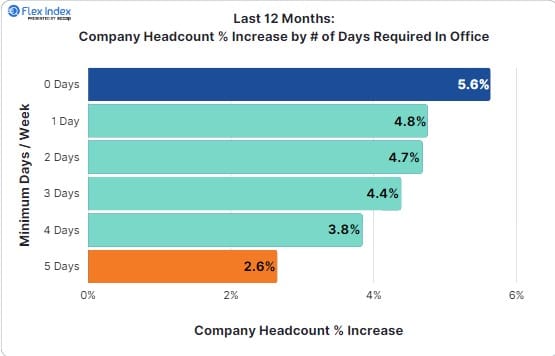Over the past 12 months, employers with flexible in-office policies have more than doubled the growth rate of the size of their workforce compared to employers that have required their employees to return to the office five days a week, according to a report released earlier this week by Scoop Technologies.
This data points to a potential correlation between talent attraction and flexibility, the report states. Meanwhile, the findings come at a time when employers are still struggling to fill positions amid near-historic low unemployment rates of 3.6%, even though the frenzied talent war years of the Great Resignation have subsided a bit.
Employers that offered full flexibility on whether employees wanted to come into the office grew their headcount by 5.6% in the past 12 months, according to data gleaned from Scoop’s Flex Index and People Data Lab’s hiring data. That was substantially higher than the 2.6% headcount growth at employers that required five days per week in the office.

Contributing factors for lower headcount growth
Dan Kaplan, senior client partner for executive recruiting firm Korn Ferry’s CHRO practice, notes a number of factors are likely behind the lower growth for employers with full-time RTO requirements.
Organizations that are requiring workers to return full-time to the office may reflect leadership that believes threats of a recession are tipping the scales in employers’ favor. Along those lines, employee surveys continually show that CEO empathy toward their workforce is in decline since the height of COVID, Kaplan says—though empathy remains a critical component of talent attraction.
“CEOs who helped lead the world through COVID are becoming a little bit more tone-deaf around empathy, holding the view that ‘COVID is now over and enough of the childish games and let’s just get back into the office and get back to work,’ ” Kaplan explains.
He also notes an inability to attract candidates may point to a larger issue of sub-par employee engagement, or even quiet quitting.
These are issues that HR can help open up discussion about, even at companies that are undergoing layoffs, hiring freezes or other cost-containment measures. And organizations with a full-time return-to-office policy need to pay particular attention to the potential impact on talent attraction, Kaplan tells HRE.
“CHROs should be concerned with both the data around the hiring growth and spend a lot of time talking with their recruiting team to understand the feedback in the market, the feedback from candidates and the feedback from employees,” he says. “People, one way or another, will vote with their feet.”
How HR leaders can make their case with the CEO
Many CHROs today are caught in the middle: facing a CEO who wants a full-time, in-office workforce and even may back RTO enforcement measures, and an employee base largely against such moves. For HR leaders concerned about the impact of RTO on recruiting and retention, Kaplan offers several suggestions.
“What’s largely been missing in this tug-of-war between the employees and CEO is an empowered HR function,” Kaplan tells HRE. “They need to really gear up and go have that tough conversation with the CEO again and again and again and bring data. They need to say, ‘Here’s the data on what our competitors are doing. Here’s the data from what we’re hearing from our people.’ ”
To have the best chance at influencing a CEO’s decision on RTO, HR should bring along real data about the business impact when employees were given a choice in their work environment.
If efforts to allow a hybrid or flexible work environment fall short, then HR leaders may need to switch their focus to employees: Stress the benefits of coming into the office and highlight the potential downsides if they work from home, Kaplan says. But these outcomes, when possible, should be presented as a choice employees need to make.
“People want to have some empowerment over their own careers,” Kaplan says.

